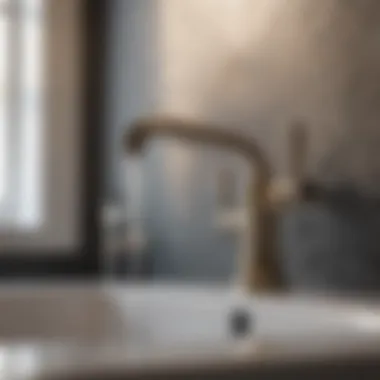Aligning Your Bathroom Faucet: A Complete Guide


Materials:
When preparing to align your bathroom faucet, a clear understanding of required materials is essential. Below is a detailed list of the materials you will need. This ensures that you have everything at your disposal before you begin your project.
- Faucet: Choose a faucet that fits your sink and meets your style preferences.
- Mounting hardware: Ensure it is compatible with your faucet model, including screws and seals.
- Plumber's tape: Approximately 1 roll, used to ensure a watertight fit.
- Caulk: 1 tube of silicone caulk to seal any gaps around the faucet.
- Washers: Various sizes, primarily rubber washers, to provide a tight seal.
- Vessel sink: If you are installing a faucet on a vessel sink, make sure it is adequate for the faucet height.
- Cleaning rags: A few, to keep the area tidy as you work.
- Bucket: To catch any water spills during the process.
DIY Steps:
Moving forward to the steps of aligning your faucet effectively, clarity and precision are paramount. Here, we outline a step-by-step guide that takes you through the installation process.
- Preparation: Start by turning off the water supply valves underneath the sink.
- Remove the existing faucet: Detach any connections and plugs holding your old faucet in place; it ensures at this stage all connections are labeled for ease during reinstallation.
- Clean the surface: Use cleaning rags to wipe the area thoroughly where the faucet will sit.
- Install the new faucet: Insert the faucet into the mounting hole, ensuring it fits properly. Use washers if necessary to prevent leaks.
- Secure the faucet: Tighten the screws from underneath, making sure it is stable but do not over tighten as this might crack the sink.
- Use plumber's tape: Wrap plumber's tape around threaded ends before connecting the hoses for extra leak protection.
- Connect water supply lines: Attach hot and cold water lines to the faucet. Ensure the connections are snug and secure.
- Check alignment: Before proceeding, double check the faucet alignment with a level.
- Seal around the faucet: Apply silicone caulk around the base of the faucet to prevent water from seeping underneath.
- Turn on the water supply: Open water valves and check for leaks. If everything is secure, operate the faucet to ensure it functions properly.
Technical Aspects:
Equipping yourself with the right tools can make a significant difference in your DIY project. Here are the tools you should gather before starting:
- Adjustable wrench: For tightening connections.
- Screwdriver set: A combination of flathead and Phillips will suffice.
- Plumber's level: Ensure the faucet is perfectly aligned.
- Caulking gun: For easy application of silicone caulk.
- Flashlight: Useful for tight or dark spaces.
Timing Specifics:
Completing this project generally ranges from one to three hours, depending on complexity and previous experience.
DIY Project Process:
The alignment process involves several sequential steps, which are crucial for ensuring a well-functioning faucet:
- Planning: Start by marking exact points where the faucet needs to be aligned.
- Installing properly: Follow previous steps closely to prevent misalignment.
- Regular checks: During installation, regularly verify alignment using the plumber's level.
- Final adjustments: Make necessary tweaks ensuring it is straight and fits snugly.
Troubleshooting Tips:
If you encounter issues during your project, several solutions can help. Remember:
- If the faucet is not aligned, loosen the screws slightly and reposition it.
- For leaks, check all connections and ensure that the plumber's tape is applied correctly.
- If the faucet wobbles, ensure the mounting hardware is secure.
Proper alignment of your bathroom faucet not only improves aesthetics but also contributes to functional efficiency.
This structured guide intends to equip both novices and experienced individuals with the insight and practical skills necessary to align their bathroom faucets effectively, ensuring a pleasing and functional addition to their bathrooms.
Foreword to Bathroom Faucet Alignment
Aligning a bathroom faucet is a fundamental aspect of ensuring both functionality and aesthetics in your home. This guide explores the intricacies of faucet alignment, which may seem trivial but carries significant importance in the overall bathroom design and usability. The precision with which a faucet is installed can affect both water flow and general satisfaction with the bathroom experience.
Understanding Faucet Alignment
Faucet alignment refers to the process of positioning the faucet correctly relative to the sink and surrounding fixtures. The goal is to ensure that the faucet operates efficiently while enhancing the visual appeal of the bathroom. Inaccurate alignment can lead to annoying issues such as splashing, reduced water pressure, or difficulty in accessing the controls. A faucet that is misaligned may not only affect water flow but also compromise the sleek look many homeowners strive to achieve in modern bathrooms.
When undertaking this task, consider the design of the faucet. Different types of faucets, such as single-hole, widespread, and center-set, have distinct alignment requirements. Each design interacts uniquely with surrounding elements, and understanding these nuances is essential to successful installation. Moreover, the goal should be a seamless integration of the faucet with the sink and countertop, minimizing visible gaps and inconsistencies that detract from the overall aesthetic.
Importance of Proper Alignment
Proper alignment has several implications that extend beyond mere aesthetics. Firstly, it impacts functionality. An aligned faucet allows for better water flow and access making day-to-day operations effortless. Homeowners often overlook the importance of this aspect until they experience problems.
Benefits of Proper Alignment:
- Enhanced Performance: A well-aligned faucet functions efficiently, conserving water and reducing waste.
- Aesthetic Appeal: An aesthetically pleasing faucet can elevate the look of the entire bathroom, giving it a polished finish.
- Easier Maintenance: A properly aligned faucet typically requires less adjustment over time, reducing maintenance hassles.


In summary, taking the time to ensure proper faucet alignment is a small investment that can yield significant benefits in both functionality and style. For those engaging in any home improvement project, understanding this principle adds substantial value to the endeavor.
Types of Bathroom Faucets
Understanding the different types of bathroom faucets is integral to the alignment process. Each faucet style comes with its own unique features, installation methods, and requirements. This awareness not only influences the aesthetic of the bathroom but also greatly impacts functionality and usability. Selecting the right faucet type simplifies the alignment process, ensuring that you have everything in place for effective installation.
Single-Hole Faucets
Single-hole faucets are characterized by a single mounting hole and a unified handle typically located at the rear. This design is champions for minimalism and works well in smaller spaces. Its compact nature allows for seamless cleaning around the sink area. Aligning this type usually requires attention to the central point over the sink, as the entire faucet sits squarely above it.
Benefits of single-hole faucets include ease of installation and straightforward operation. Fewer components also mean fewer parts that can experience misalignment. However, it is important to ensure the water supply lines are not twisted during installation to avoid future issues.
Widespread Faucets
Widespread faucets consist of three separate pieces: two hot and cold handles and the spout. This allows for a wider installation range, typically requiring three holes on the sink. Because widespread faucets give options for spacing, aligning them can be more complex compared to single-hole faucets.
When aligning widespread faucets, there are several factors to consider: handle placement, spout location, and overall symmetry. Ensuring that each component is equidistant creates an organized and polished look. The flexibility of this faucet type can enhance the visual appeal of the sink area, but it does require careful planning to achieve precise alignment.
Center-Set Faucets
Center-set faucets merge the functionality of wide-spread and single-hole faucets. They typically consist of three pieces but are mounted on a single base, making installation simpler than widespread models while still offering some design variety. This type usually requires three holes: one for the spout and two for the handles.
For center-set faucets, the critical consideration during alignment is making sure the spout is directly between the handles. Improper alignment can easily lead to uneven spacing between the components, impacting both the look and function. Thus, taking extra care in measuring and positioning these faucets is crucial.
In summary, each faucet style requires specific considerations for alignment. Understanding these distinctions can lead to better planning, improved aesthetics, and enhanced functionality in your bathroom.
Tools Required for Alignment
Properly aligning a bathroom faucet is crucial for both its aesthetic appearance and functional efficiency. The right tools streamline the process, saving time and reducing frustration. Understanding what tools are necessary lays the groundwork for a successful faucet installation or adjustment.
Choosing the right equipment ensures that you can achieve the precision needed for alignment. Moreover, certain tools help prevent damage to the faucet and surrounding fixtures. This section delves into the essential hand tools, measuring instruments, and safety equipment required for faucet alignment.
Essential Hand Tools
In this process, hand tools play a vital role. Without them, aligning your faucet accurately can become challenging.
- Adjustable Wrench: This tool is essential for loosening and tightening the nuts securing the faucet in place.
- Screwdriver Set: Different types of screws may hold your faucet, so having both flat-head and Phillips screwdrivers is necessary.
- Pliers: Useful for gripping small parts if you need extra leverage, especially in tight spaces.
- Utility Knife: This can help in cutting any old caulking or seals that may interfere.
These tools are straightforward and often found in most household toolkits, making them accessible to everyone. Additionally, each tool serves a specific purpose, allowing for clean and efficient work.
Measuring Instruments
Accurate measurements are the foundation of a well-aligned faucet. You would not want to place your faucet unevenly, which can lead to water spilling or creating an unbalanced look in your bathroom.
- Tape Measure: Essential for measuring the distance between sink holes and faucet placement.
- Level: This tool will help check if your faucet is aligned properly, ensuring both horizontal and vertical straightness.
- Square: This is useful for ensuring right angles, particularly if you're dealing with a widespread faucet setup.
Having these measuring tools on hand will guarantee that you are positioning your faucet correctly. Precision at this stage can save you from costly readjustments later on.
Safety Equipment
Safety should be a priority during any DIY project, including faucet alignment. Using the right safety equipment can prevent accidents and injuries.
- Safety Goggles: Protect your eyes from debris, especially if you are cutting or loosening old materials around the faucet.
- Gloves: These provide both grip and protection from sharp edges and chemicals, like cleaning solutions.
- Knee Pads: If you're working on the floor, knee pads make it more comfortable to get into tight spaces without straining your knees.
Being adequately equipped not only helps you achieve your goals but also ensures that you do it safely. Having the essential tools and safety gear will lead to a more efficient and enjoyable faucet alignment experience.
Preparation for Faucet Alignment


Preparation is a critical step before proceeding with the alignment of a bathroom faucet. Adequate preparation ensures a smooth workflow and minimizes potential complications during installation. Without proper groundwork, even a simple task can become cumbersome and frustrating. Thus, taking time to prepare can lead to a more efficient process, yielding both time and resource savings.
Shutting Off Water Supply
Before starting any work on your faucet, shutting off the water supply is essential. This step is crucial in preventing water from flowing during installation. Locate the shut-off valves, typically situated beneath the sink. Turn them clockwise until they are fully closed.
Remember: Always double-check that the water supply is off by turning on the faucet after shutting the valves. This action will confirm that no water is leaking or coming through.
If your faucet lacks shut-off valves, you may need to turn off the water supply for the entire house. Although this entails more work, it is necessary to ensure safety.
Gathering Tools and Materials
Next, you will need to gather all tools and materials required for the alignment process. Having everything on hand avoids interruptions and allows for a fluid workflow. The basic tools generally needed include:
- Adjustable wrench
- Screwdriver (flat-head and Phillips)
- Plumber's tape
- Level
- Measuring tape
In addition to tools, certain materials may be essential, such as replacement washers or plumbing sealant. Ensuring that these materials are readily accessible will streamline the installation process.
Taking the time to prepare properly not only simplifies the task but also enhances safety and efficiency. With all necessary preparations in place, you can now approach the next steps with confidence.
Step-by-Step Alignment Process
The Step-by-Step Alignment Process is crucial in the context of aligning a bathroom faucet. This section aims to methodically guide readers through the necessary actions, ensuring an effective installation. Proper faucet alignment not only enhances the visual appeal but also contributes to the overall functionality of the bathroom. By following each step attentively, DIY enthusiasts can avoid common pitfalls that may arise during the installation or adjustment period.
Removing the Old Faucet
The first step in the alignment process involves removing the existing faucet. This stage may seem simple, but it can present challenges. Begin by ensuring that the water supply is turned off. This precaution is essential to prevent any unwanted leaks or water flow during removal.
Use a basin wrench to loosen the nuts that secure the faucet to the sink. It's advised to keep a cloth or towel handy to catch any residual water that may drip during disassembly. Carefully disconnect supply lines and pull the faucet upward to free it from its position. Inspect the area for buildup or residue that may hinder the new installation. A clean surface allows for better sealing and alignment.
Installing the New Faucet
With the old faucet removed, the next step is to install the new faucet. Before proceeding, verify that all components are present as per the manufacturer's instructions. Align the new faucet with the pre-drilled holes in the sink. The alignment should feel stable without any excessive force.
Secure the faucet by tightening the mounting nuts underneath the sink while ensuring the faucet remains in position. This part of the process requires attention to detail; overtightening can cause damage while loose fittings can lead to leaks. It might help to use a plumber's putty or silicone sealant around the base for added support. Let it cure as per the noted time on the sealant's package before proceeding further.
Achieving Correct Positioning
Achieving correct positioning of the faucet is the final aspect of this process. After securing the faucet, check its alignment with the sink’s edge and the spout's angle. The faucet should be straight and centered. Adjust as necessary by loosening the mounting hardware slightly, repositioning the faucet, and retightening.
It is beneficial to visually inspect the faucet from different angles to ensure an even look. Once satisfied, reconnect the supply lines and turn the water supply back on. Conduct a test to ensure water flows correctly without any leaks or obstructions. This final check solidifies the installation, allowing homeowners to enjoy a beautifully aligned faucet.
Testing and Adjustment
Testing and adjustment are critical final steps in aligning your bathroom faucet. These processes ensure that the faucet not only looks aesthetically pleasing but also functions effectively. A well-aligned faucet enhances the overall experience in the bathroom. It prevents frustration caused by water pooling or splashing outside the sink area, and it helps avoid potential water damage to the vanity or surrounding areas.
After successfully installing your faucet, you must carry out several tests. This includes checking for leaks and adjusting the positioning as necessary. This stage is essential because it provides the opportunity to identify any issues that may not have been apparent during the installation. Proper testing and adjustment can prolong the life of your faucet and ensure that the investment you have made into your home is not wasted.
Checking for Leaks
Once you have installed the faucet, checking for leaks is one of the first steps to take. Start by turning on the water supply and running water through the faucet. Keep your eyes peeled for any dripping or pooling of water around the base or under the sink.
Leakages can occur due to several reasons, including improper tightening of fittings or worn washers. If you detect any leaks:
- Turn off the water supply to prevent any damage from excessive water accumulation.
- Inspect all connections and ensure they are tightened adequately.
- If a leak persists, replace worn washers or seals as needed. This will help maintain the functional integrity of the faucet.
"A small leak can lead to larger problems later. Always address leaks immediately to maintain function and beauty in your bathroom."


By diligently checking for leaks, you protect your home from the risk of water damage and ensure your faucet operates properly.
Fine-Tuning the Alignment
After confirming there are no leaks, you can focus on fine-tuning the alignment. This step ensures the faucet sits level and functions smoothly. It's critical to look for any discrepancies in the alignment as minor misalignments can lead to improper operation or even aesthetic issues.
To fine-tune the alignment:
- Check horizontal and vertical alignment: Use a level tool to verify that the faucet is perfectly aligned. Adjust as necessary.
- If you notice an uneven flow of water from the faucet, you may need to adjust the positioning slightly.
- Tightening or loosening screws: Sometimes, the screws that hold the faucet in place need adjustment. Be cautious to avoid over-tightening which can damage the units.
Taking the time to adjust the alignment not only improves the functionality of the faucet but also enhances the overall look of your bathroom. It is a small yet significant step in achieving a well-designed bathroom space.
Troubleshooting Common Issues
When it comes to bathroom faucet alignment, addressing issues that arise during or after installation is crucial. Many homeowners underestimate the impact of a misaligned faucet. This section provides insights into common problems and the steps to resolve them effectively. A well-aligned faucet enhances both aesthetics and functionality, making troubleshooting an essential skill for homeowners.
Misalignment Symptoms
Recognizing the symptoms of faucet misalignment is the first step in troubleshooting. These issues can manifest in various ways. Common signs include:
- Uneven Water Flow: If water sprays unevenly, it might suggest that the faucet is not positioned correctly.
- Visible Gaps: Any gap between the faucet base and the countertop signals improper installation.
- Difficulty in Operation: If turning the faucet on and off feels strange or gets stuck, it may be misaligned.
- Leaking Water: Water pooling around the faucet base indicates not just potential misalignment but also possible sealing issues.
Understanding these symptoms enables timely intervention, which prevents further complications. Problems left unresolved can lead to increased water bills, damage to cabinetry, or even mold growth in severe cases.
Solutions for Misalignment
Once you identify that there is a misalignment issue, addressing it promptly is essential. Several solutions can rectify the common problems mentioned above:
- Re-Adjusting the Faucet: Simply loosening the mounting hardware can sometimes allow you to reposition the faucet carefully. Ensure that it is level and tightens the hardware securely after adjustment.
- Inspecting the Seal: If there are leaks, examine the rubber gaskets or seals. Replacing worn-out seals typically resolves leakage issues.
- Using a Level: Always use a level tool to check that your faucet sits straight. If not, slight adjustments may be necessary to achieve a balanced position.
- Tightening Connections: Ensure all connections are secured properly to avoid leaks and ensure stability.
Following these solutions can significantly improve faucet performance, safeguarding the integrity of your bathroom space.
Preventive Measures
Preventing misalignment in the first place is a more effective approach than addressing the problems after they occur. Consider the following preventive measures:
- Choose Quality Materials: Invest in quality faucets that come with reliable installation hardware to minimize the chance of misalignment.
- Follow Installation Instructions: Adhere strictly to the manufacturer's installation guidelines. Skipping steps can lead to problems down the line.
- Inspect Once Installed: After installation, double-check the alignment and water flow. Making adjustments before full use can save time and hassle.
- Regular Maintenance: Periodic inspections of your faucet can help in identifying early signs of misalignment and wear, allowing for timely repairs.
Maintaining vigilance during installation and regular check-ups can significantly reduce the likelihood of alignment issues, ensuring that your bathroom faucet remains functional and stylish for years to come.
Remember, a well-aligned faucet can make a crucial difference in both the operation and aesthetic appeal of your bathroom.
End and Final Thoughts
The conclusion of this guide on aligning your bathroom faucet serves as a crucial point for summarizing the essential elements discussed. It reinforces the idea that proper faucet alignment not only enhances the overall aesthetic appeal of a bathroom but also ensures a well-functioning water fixture. By recapping the steps and considerations presented throughout the article, readers can appreciate how each element fits into the larger picture of home maintenance and improvement.
Alignment is significant. It prevents potential leaks, reduces wear and tear on plumbing components, and contributes to the longevity of the faucet. Ignoring alignment can lead to issues that progress over time, causing inconvenience and costly repairs. Ensuring accurate positioning can improve water flow and maintain the visual harmony of your space.
Additionally, addressing the importance of future maintenance can help homeowners stay on top of their faucet's performance. Regular checks and adjustments can keep the faucet in optimal condition, providing peace of mind long after the initial installation.
"A small step in ensuring proper faucet alignment can lead to a significant enhancement in functionality and style."
Recap of Key Points
- Proper alignment is vital for aesthetic appeal and functional efficiency.
- Misalignment can cause leaks and reduce the lifespan of plumbing components.
- Understanding types of faucets can influence installation and alignment techniques.
- Essential tools and safety equipment are necessary for a smooth alignment process.
- Regular maintenance can prevent future alignment issues and extend the faucet’s lifespan.
Future Considerations for Faucet Maintenance
When thinking about the longevity of your faucet and its fitting, maintenance should not be overlooked. After installing your faucet, consider these points for future care:
- Routine Checks: Periodically inspect the faucet for any signs of misalignment or leaks.
- Cleaning: Regularly clean the faucet and its surrounding area to prevent the build-up of grime, which can affect functionality.
- Tightening Loose Components: Ensure that all fittings remain secure, as even minor looseness can lead to misalignment over time.
- Replacement of Worn Parts: Address any wear on seals and washers promptly, as these components are critical in maintaining an effective seal.
- Consulting Professionals: If you notice ongoing issues, do not hesitate to consult a plumbing professional to evaluate and resolve any underlying problems.
By implementing these considerations, homeowners can ensure that their faucets continue to operate effectively and maintain their intended alignment, thereby enhancing the overall experience of their bathroom.







